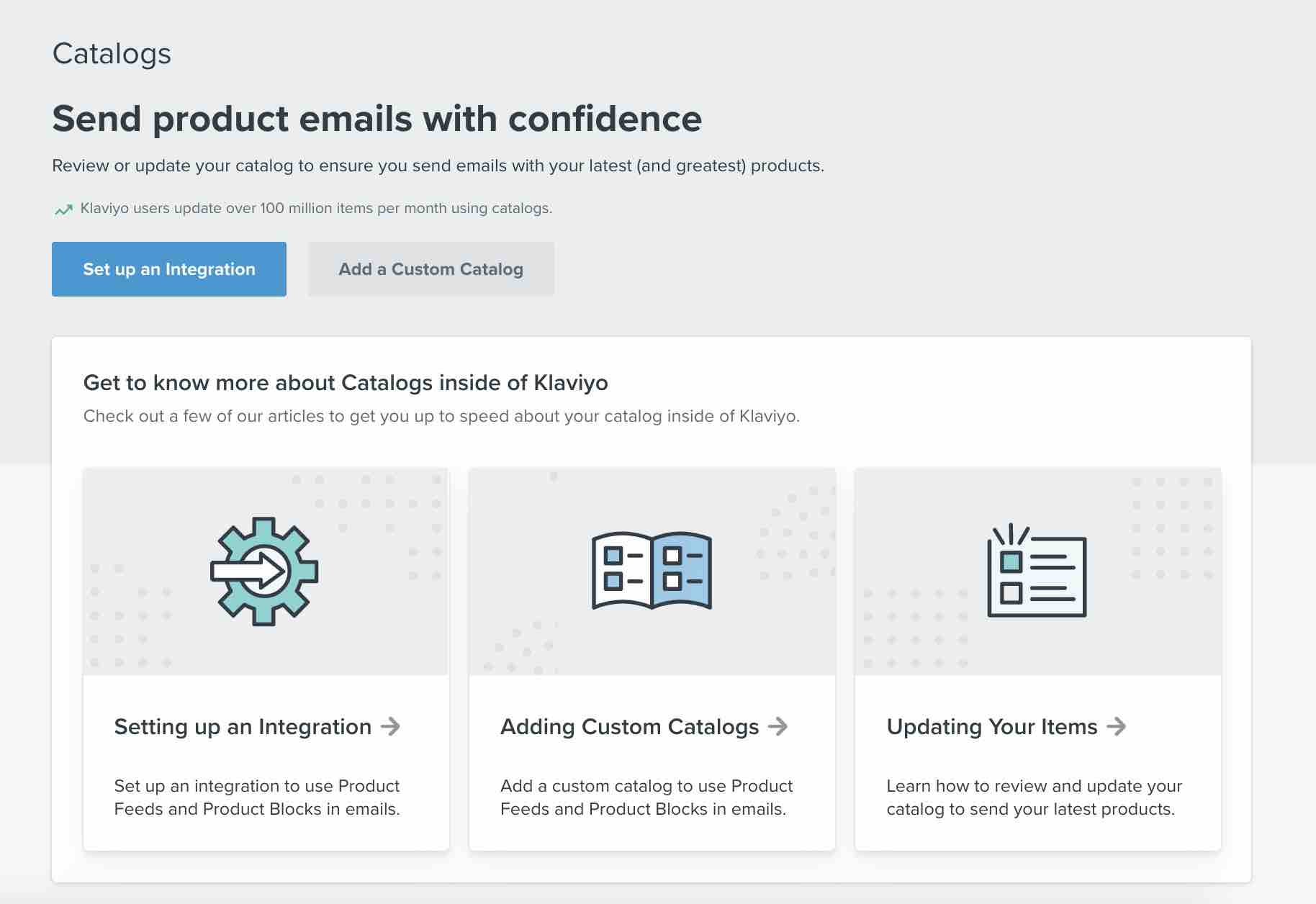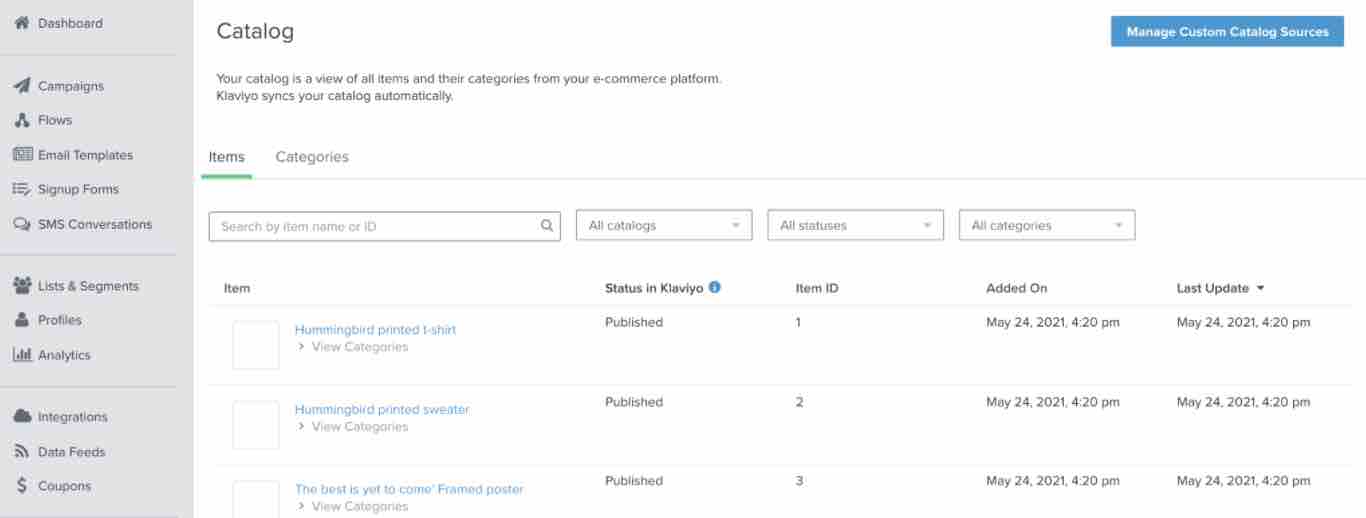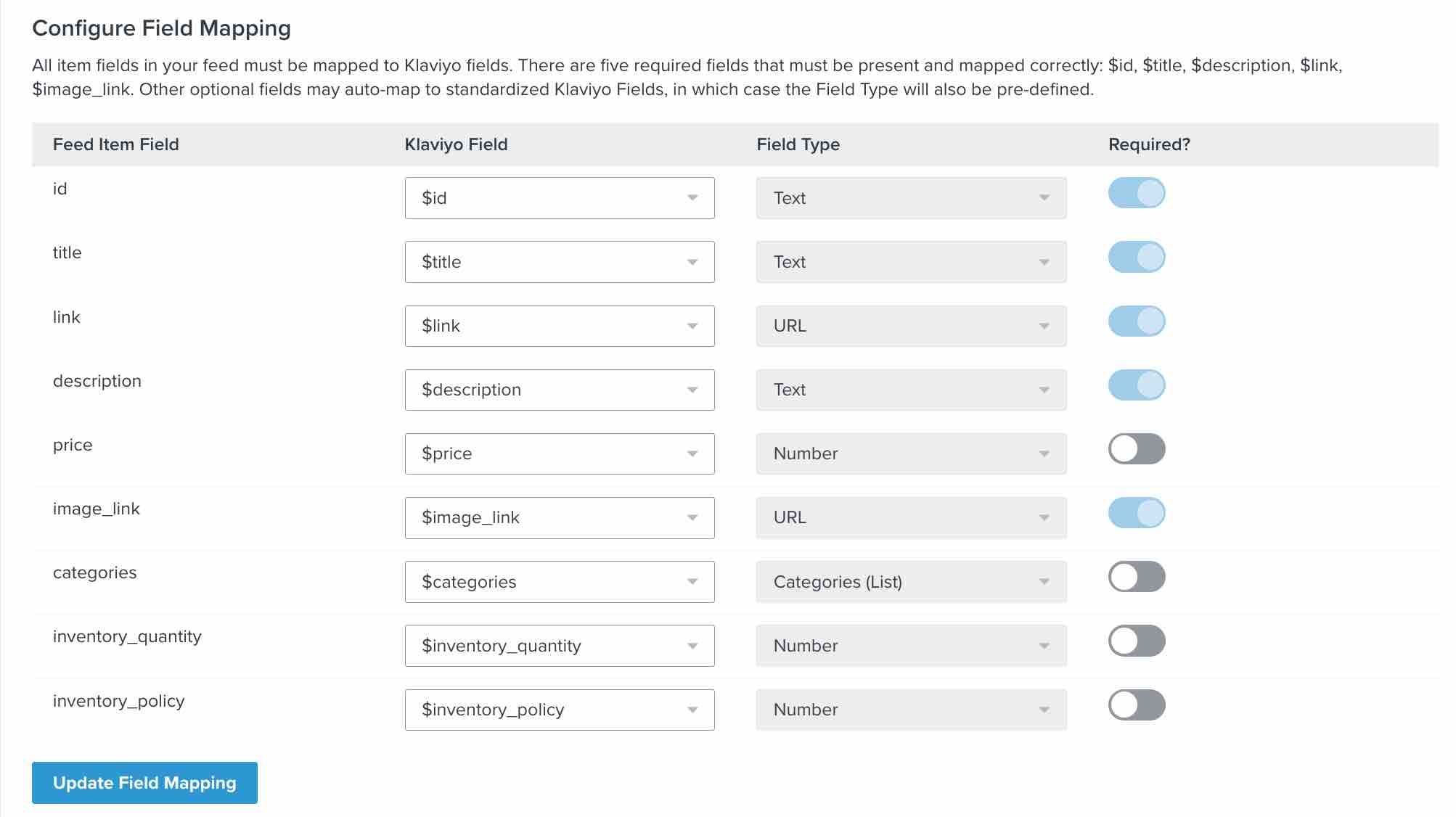Sync a custom catalog feed to Klaviyo
Learn how to sync a custom catalog feed to Klaviyo.
If your catalog feed is not synced by one of our pre-built ecommerce integrations, or you have catalog information stored in another system, you can use Klaviyo's custom catalog sync feature. Then, you can use items from that catalog feed to populate emails.
This guide will walk you through the requirements for your custom catalog feed and how to sync your custom catalog feed to Klaviyo. Once your feed has been built and synced to your Klaviyo account, you will be able to use Klaviyo’s product recommendation, product block, and catalog lookup tag features. Klaviyo resyncs the information from a given catalog feed source every six hours.
For free accounts
As discussed below, in order to finalize your catalog feed (and, in order to sync your catalog feed if it has more than 1 million items), you must contact Klaviyo's customer support team. If you are using Klaviyo's free plan, you have 60 days of dedicated email support after account creation during which you can submit a request. After the 60 day period, you must upgrade your account to submit further requests.
Using custom catalog content
The custom catalog feature can be used to leverage product feeds and easily insert hand-picked catalog items in an email, as well as Klaviyo-generated personalized product recommendations. To learn how, check out Use custom catalog data in emails. Your custom catalog source can contain anything that you would consider to be “items” you want to share or recommend to your subscribers, whether these are products, store locations, ticketed events, or blog articles.
Custom catalog requirements
Klaviyo can sync custom catalog feeds that meet the following requirements:
- The catalog is a public, hosted feed of all the items in your catalog.
- If you do not have your own feed hosting location, you can use a service such as Google Merchant feeds.
- The feed is in JSON or XML. Check out an example feed in JSON and an example feed in XML.
- The feed is accessible on an HTTPS URL.
- The data in the feed is only one node deep, not nested JSON or XML (unless it is hosted on Google Merchant Feeds).
- The size of any one feed file should not exceed 100 MB; for optimal performance, we recommend each feed file not exceed 50 MB. If your file exceeds this amount, please split the feed into multiple files. All files used as sources will feed into the same catalog in Klaviyo.
- Required fields must not be left blank. For unavailable numeric fields, pass a zero (0), and for unavailable text fields, pass something indicating this such as “n/a” or “unavailable”.
- If your feed is hosted with a caching layer, disable caching for the location where the feed is hosted or refresh this cache when the feed is updated. Otherwise, Klaviyo will only pull updated data for the feed items after the cache is refreshed.
If your feed will have more than 1 million items, please contact Klaviyo support before you reach the “Add feed to account” step of this setup. This will allow us to pre-allocate necessary resources on our end to better optimize for larger catalog sizes.
Mappable catalog properties
You can include any data you want in your custom catalog feed. In addition to the data you choose to include, Klaviyo also has some special mappable properties that unlock certain features of our platform. Below is a list of the required and optional fields available for our default catalog feed setup.
Required fields
In order for the mapping step of the catalog setup to work, the following required fields must be included for each item in the feed. The name in parentheses is the field that they will map to in Klaviyo:
- Unique ID ($id): Can be text, numeric, or alphanumeric, but must be unique
- Title ($title): The name of the item
- URL ($link): The URL at which a person can find this item
- Image URL ($image_link): A URL at which the image for this item is hosted, which must use https
- Description ($description): A text description of the item
The Unique ID ($id) of an item in the feed must match the item ID in the metric you want to use for personalized recommendations. For example, if you pass an Ordered Product metric to Klaviyo, the value passed as a “Product ID” property must match the Unique ID of that product in your catalog feed. You can also map multiple metric types - for instance, if you have a Viewed Product metric, and a Point of Sale Purchase metric, you could map Viewed Product via ProductID and Point of Sale Purchase via SKU, as long as both correspond to their respective Unique IDs in the catalog.
To find the Product ID in an Ordered Product metric, navigate to the Analytics tab in your Klaviyo account and click Metrics. Find the Ordered Product metric in the list or via search, click on it, then click Activity Feed. Here you will find individual metrics. Click on Details for an individual metric to show the full metadata for that metric, including the Product ID.

Optional fields
In addition to the required fields above, we also recommend passing the following optional fields (the name in parentheses is the field that they will map to in Klaviyo):
- Price ($price): The numeric item price, with no currency symbol
- Categories (categories): A comma-separated list/array of categories, tags, or collections
associated with an item
Additionally, there are fields that can be added to enable Back in Stock. Enabling Back in Stock relies on item inventory tracking. Include additional fields for:
- Inventory ($inventory_quantity): a number representing the stock for a given item.
You can also include the following optional parameter:
- Inventory Policy ($inventory_policy): a number that controls how Klaviyo treats product visibility in product feeds and blocks. This field has two available options:
- 1: If the policy is set to 1, a product will not appear in dynamic product recommendation feeds and blocks if it is out of inventory quantity
- 2: If the policy is set to 2, a product can appear in dynamic product recommendation feeds and blocks regardless of inventory quantity. This is also the behavior when this field is not set.
Catalog property considerations
As you set up your catalog feed, here are some functionality considerations to keep in mind:
- The only way to filter your feed in Klaviyo is by category names. If there is something you want to filter your feed by, make sure to include it as a category.
- Make sure the first item in your feed contains all available fields (in case some of your items do not). The mapping step of the catalog sync draws on the fields from the first item in the feed, so it is important that all fields are present in order to map successfully. For example, if some of the items in your feed contain eight fields, but some items only contain six of those fields, the first item in the feed should contain all eight fields.
Sync your catalog
Add your feed
Once your feed is set up and hosted at a URL, add it to your account.
Navigate to the Catalog tab in Klaviyo. If this is your first custom catalog feed sync, you’ll see the following page. Click Add a Custom Catalog to be brought to the custom sources page (see below).

If you’ve added a custom catalog feed before and navigate to the Catalog tab, you’ll see the following page. Click Manage Custom Catalog Sources in the upper right corner. This step will also bring you to the custom sources page.

Click Add New Source. This will bring you to the define feed source page.

Name your feed source and add the URL. You can optionally add a username and password if access to the feed URL requires them (your feed URL will determine this setting). Then, click Define Source.

You’ll receive a green success callout showing your source has been added.

Map feed fields
After your feed has been added as a catalog source, you can configure the feed fields mapping. From the Custom Sources page, click Configure field mapping under Status next to the source.
Klaviyo will try to automatically map the fields in your feed based on their name, but if they do not automatically map, you may need to set them yourself. Make sure to map price to $price in order to leverage it for product blocks. Using all of the required and optional properties above, your mapping should look like this:

Toggle a field “on” in the Required column to tell Klaviyo to only sync items that include that designated field. This is auto-populated for fields required by Klaviyo and can be optionally toggled on for additional fields.
If your catalog has extra fields you would like to include, such as inventory fields to enable Back in Stock, you can create a new field by typing the new field name into the Klaviyo Field column for that field and clicking Create “Option”.

Finalize your catalog
Once you’ve mapped the catalog feed in your account, the last step in the setup process is to reach out to our Support Team with the following information:
-
The name of the metric (or metrics) in your account you would like to use for personalized, popular, and trending recommendations. These metrics can be Ordered Product, Viewed Product given that you’re tracking those events in your account, or any custom metric sent via API.
- If you’ve set up an Added to Cart event, Klaviyo will automatically configure it for use in product feeds based on Products a customer has added to cart
- You can request as many metrics as you like to be configured for use in personalized recommendations, though each metric must be leveraged in its own feed. The exception is Viewed Product and Ordered Product, which can be used together.
- You cannot currently use metrics synced via a built-in Klaviyo ecommerce integration (for example, an Ordered Product metrics from Shopify) in conjunction with a custom catalog for product recommendations. Your Ordered Product event must be sent via API. Shopify Viewed Product and Added to Cart events are excluded from this rule because they are created via Klaviyo tracking. This ability will be added in a future release.
- Within the product feeds builder, there are various options you can choose that correspond with the selected metric. For example, if you select Viewed Product, you can base product recommendations on most viewed products overall, or products that a customer has recently viewed.
-
The name of the property in that metric’s metadata which corresponds to the Unique ID ($id) used in your catalog feed (e.g., Product ID).
Once this step is complete, you will be able to access and use the Product Feed and Product Block features.
Delete a source
- Deleting a catalog source will not delete the items in your catalog, it will only delete the connection between the source and Klaviyo, and no new updates will occur.
- If you are interested in deleting catalog items, please reach out to our Support Team.
If you want to delete a custom catalog feed source, such as a test source you are no longer using, navigate to Catalog > Manage Custom Catalog Source and click the three dot dropdown next to the source to be deleted. Then, click Delete.

Additional resources
Updated almost 3 years ago